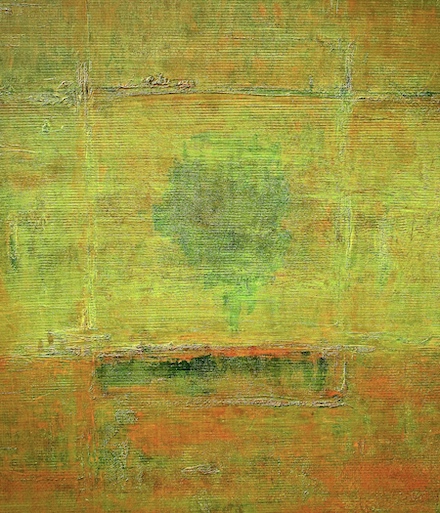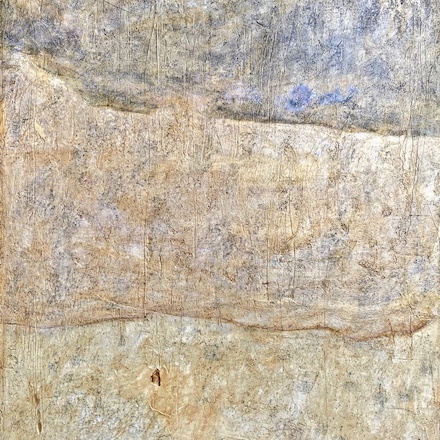
|
|
|
|
|
| Issue 26: | 1 Jan. 2025 |
| CNF, Memoir: | 53+158[R]+85 |
| +125+131 words |
Writing by Kate Flannery
Visual art by Kendall Johnson
Five Vignettes from The Book of Michael 1
Water Days, 1954
At age nine he could knife through the swimming pool like a dark eel, his wet olive skin reflecting the light from the reluctant Northwest sun. In a race, his brown eyes focused hard on his path to the finish. He was a slippery boy who wanted to go fast.
To the Lake, 19602
Straddling my bike in the garage, I realize I have been left behind again. Whippet-thin, my older brothers can hop on their bicycles and be half a mile away before I get onto my pink, fat-tired bike. We ride in any Northwest weather, mostly the wet kind. But there are days like this July day where the sun dazzles us and brings us out to the sidewalks and streets, like worms after a rain. I know every alley in our small town, their edges filled with things to eat and smell: rhubarb, sweet peas, blackberries, and neighbors’ fruit which hangs heavily over the alley walls. Black gravel shoots up behind me as I speed past it all, trying to catch my brothers, with Michael in the lead, all of them well into their marauding. They’re racing toward the lake where the northern geese nest in the dark bulrushes. Where I’m not supposed to go.

Painting © by Kendall Johnson3
The Healers, 1960
We were all going to be doctors. Following the lead of our oldest brother, 14 years my senior, who graduated from elite universities at the top of every class, Michael, John, and I also set our sights on Med School and beyond. And one by one we dropped the plan. Michael put that dream aside when, at 16, he fainted upon seeing his own blood on the floor of his bathroom. Instead, he chose the law. A different way to draw blood.
The Hunter, Early 2024
Weeks after stopping his chemotherapy, Michael sits up in bed and leans back into the pillows, punched and faded. His eyes glisten just before he shapes them into slits. His lips become thinner, almost disappearing.
“I am the hunter,” he says softly. “I hunt them down.”
He’s talking about the bad guys. The ones who run their businesses profitably with little concern about taxes owed. As a high-level litigator for the Internal Revenue Service, he used stealth and charm to aim his investigations at his targets and bring them to trial. He has recovered millions for the government.
Now, he lets the cancer come to him. He does not avoid this hunter, and I wonder if he thinks he’s its equal.

Painting © by Kendall Johnson4
Hands, May 2024
There comes a point in dying when the face slackens, the jaw becomes exaggerated. The flesh of the face begins to wilt and can’t hold itself up.
Michael’s bones, though filled with cancer, look strong, and he can form a fist in frustration and effort when he tries to swallow. But his hands, long-fingered, curved and tender in the sun’s light, are still without age spots, smooth and veinless. I remember his fingers, with the tips of their pads strong enough to press the wires of his 12-string acoustic guitar so the sound of his strumming would be full and rich.
I have seen those hands before, on Michelangelo’s David as the young shepherd surely grips a rock in his fist. Ready for hurling against the giant enemy.
Footnotes:
1. Vignettes are from the manuscript The Book of Michael—Presence, Absence, and Things In Between by Kate Flannery, with artworks by Kendall Johnson; vignettes and paintings appear here with their permissions.
2. Earlier versions of “To the Lake, 1960” first appeared in Cholla Needles (Issue 59, November 2021), and in Kate Flannery’s Northwest Passages—A Micro-Memoir (Arroyo Seco Press, 2023).
(Note: In the upper right corner of this content column, the [R] in the second word count refers to reprinted, aka republished or re-curated work.)
3. Reproduction of a painting (acrylic on canvas, 2016) by Kendall Johnson, #10 from his Melting Into Air Series.
4. Reproduction of a painting (acrylic on canvas, 2016) by Kendall Johnson, #22 from his Melting Into Air Series.
Kate Flannery
is an Editor-at-Large for The Journal of Radical Wonder, where she writes the bi-weekly column “Interludes.” She is also a writer, lawyer, and musician who lives in a small college town. Her essays, poetry, and fiction have been published in Chiron Review, The Ekphrastic Review, Emerge, MacQueen’s Quinterly, Pure Slush, and Shark Reef. In 2022, she was a finalist for Bellingham Review’s Annie Dillard Award for Creative Nonfiction.
She works regularly with the Sasse Museum in Pomona, California, contributing to exhibition catalogs for the museum as well as writing ekphrastic poetry in response to the artwork on display there. Her current projects include a curated volume about Palmer Canyon in the wake of the Grand Prix Fire of 2003; a collection of reflections on the 2024 death of her brother: A Book of Michael—Presence, Absence, and Things In Between; and a collection of prose poems in collaboration with Kendall Johnson and John Brantingham, Prayers for Morning: Twenty Quartets (MacQ, 25 December 2024).
Kate’s website: https://kateflannerywrites.com/about
More on the Web: By, About, and Beyond
⚡ Halcyon Days: A Lyric Essay in Cadralor Form in MacQueen’s Quinterly (Issue 20X, November 2023)
⚡ “What Is It? What Does It Mean?” (9 May 2022), the inaugural essay in Kate Flannery’s series about Father Bill Moore and his abstract art, which she wrote for the “Interludes” column in The Journal of Radical Wonder
⚡ The Logic of Mockingbirds, prose poem in Grey Sparrow Journal (Issue 39, Winter 2022)
⚡ Living Like Squirrels in Northwest Review online: Features: Flash (date unspecified)
| Copyright © 2019-2025 by MacQueen’s Quinterly and by those whose works appear here. | |
| Logo and website designed and built by Clare MacQueen; copyrighted © 2019-2025. | |
|
Data collection, storage, assimilation, or interpretation of this publication, in whole or in part, for the purpose of AI training are expressly forbidden, no exceptions. |
At MacQ, we take your privacy seriously. We do not collect, sell, rent, or exchange your name and email address, or any other information about you, to third parties for marketing purposes. When you contact us, we will use your name and email address only in order to respond to your questions, comments, etc.